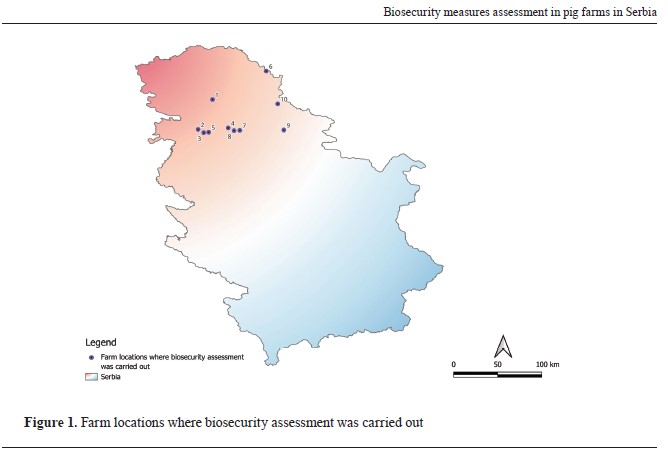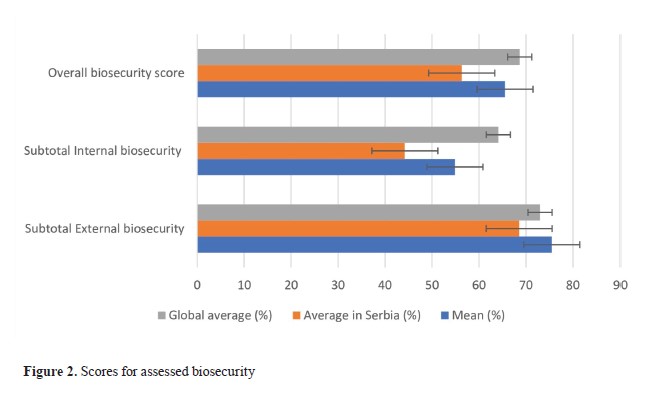2. Food and Agriculture Organization of the United Nations/World Organisation for Animal Health/ World Bank. (2008). Biosecurity for highly pathogenic avian influenza- Issues and options in developing and transition countries. Rome: FAO Animal Production and Health Paper No. 165.
7. Oļševskis, E., Guberti, V., Seržants, M., Westergaard, J., Gallardo, C., Rodze, I., Depner, K. (2016). African swine fever virus introduction into the EU in 2014: experience of Latvia. Res Vet Sci. 105, 28-30.
https://doi.org/10.1016/j.rvsc.2016.01.006 PMid:27033903
8. Moya, S., Tirado, F., Espluga, J., Ciaravino, G., Armengol, R., Diéguez, J., Yus, E., et al. (2020). Dairy farmers’ decision-making to implement biosecurity measures: A study of psychosocial factors. Transbound Emerg Dis. 67(2): 698-710.
https://doi.org/10.1111/tbed.13387 PMid:31600857 PMCid:PMC7079090
9. Stygar, A.H., Chantziaras, I., Toppari, I., Maes, D., Niemi, J.K. (2020). High biosecurity and welfare standards in fattening pig farms are associated with reduced antimicrobial use. Animal 14(10): 2178-2186.
https://doi.org/10.1017/S1751731120000828 PMid:32349838
10. Bernaerdt, E., Maes, D., Van Limbergen, T., Postma, M., Dewulf, J. (2022). Determining the characteristics of farms that raise pigs without antibiotics. Animals (Basel). 12(10): 1224.
https://doi.org/10.3390/ani12101224 PMid:35625070 PMCid:PMC9137792
11. Dhaka, P., Chantziaras, I., Vijay, D., Bedi, J.S., Makovska, I., Biebaut, E., Dewulf, J. (2023). Can improved farm biosecurity reduce the need for antimicrobials in food animals? A scoping review. Antibiotics (Basel). 12(5): 893.
https://doi.org/10.3390/antibiotics12050893 PMid:37237795 PMCid:PMC10215210
12. Chantziaras, I., Dewulf, J., Van Limbergen, T., Stadejek, T., Niemi, J., Kyriazakis, I., Maes, D. (2020). Biosecurity levels of pig fattening farms from four EU countries and links with the farm characteristics. Livest Sci. 237, 104037.
https://doi.org/10.1016/j.livsci.2020.10403713. Kureljušić, B., Savić, B., Milovanović, B, Maletić, J., Ninković, M, Jezdimirović, N., Prodanov Radulović, J. (2023). Assessment of biosecurity measures in the commercial (industrial) pig farms in Serbia. Book of abstracts of the 2023 Ann. Gen. Meet. of the Cost Action CA20103 Better, February 7-8 (p. 39), Ghent, Belgium
14. Maletić, J., Spalević, L., Milićević, V., Glišić, D., Kureljušić, B., Kureljušić, J., Maletić, M. (2023). Assessment of biosecurity measures implemented on the broiler farms in the region of Belgrade city. Vet. Glasnik. 77(2): 125-136.
https://doi.org/10.2298/VETGL230403003M 15. Polaček, V., Mirčeta, J., Prodanov-Radulović, J. (2021). Key risk factors and impact of African swine fever spreading on pig production in Serbia. Acta Vet. 71(4): 371-391.
https://doi.org/10.2478/acve-2021-0032 16. Prodanov-Radulović, J., Nunes, T., Chantziaras, I., Kureljušić, B., Piccirillo, A., Tilli, G., Allepuz, A. (2023). Mapping biosecurity measures applied on different animal production systems across Europe -Progress of COST Action BETTER. Book of Abstracts, 15th Epizone Ann. Meet. New Perspect. for the New Era, April 26-28 (p. 158), Novi Sad, Serbia
17. Radović, Č., Petrović, M., Gogić, M., Radojković, D., Živković, V., Stoiljković, N., Savić, R. (2020). Autochthonous breeds of Republic of Serbia and valuation in food industry: Opportunities and challenges. IntechOpen
https://doi.org/10.5772/intechopen.88900 18. Nielsen, S.S., Alvarez, J., Bicout, D., Calistri, P., Depner, K., Drewe, J.A., Garin-Bastuji, B., et al. (2019). Risk assessment of African swine fever in the south-eastern countries of Europe. EFSA J. 17(11): 5861.
https://doi.org/10.2903/j.efsa.2019.5861 PMid:32626162 PMCid:PMC7008867
19. Prodanov-Radulović, J., Đurđević, B., Petrović, J., Mirčeta, J., Polaček, V. (2022). African swine fever: A biosecurity challenge for domestic pig production in Serbia. Arh Vet Med. 15(2): 21 38.
https://doi.org/10.46784/e-avm.v15i2.310 20. Statistical Office of the Republic of Serbia (RZS). (2023). No. 033; PO12; c2024 [cited March 26].
https://publikacije.stat.gov.rs/G2023/HtmlL/ G20231033.html
21. Kureljušić, B., Milićević, V., Milovanović, B., Glišić, D., Maletić, J., Jezdimirović, N., Kureljušić J., et al. (2023). Assessment of biosecurity measures in the Serbian backyards where the first African swine fever cases were confirmed. Proceedings of the 14th Eur. Symp. Porcine Health Manag. May 31-June 2 (p.253), Thessaloniki, Greece
22. Statistical Office of the Republic of Serrbia, Announcement Series: ISSN 0353-9555, Announcement No: 034, Code: PO12, Number of Livestock 2023
https://publikacije.stat.gov.rs/G2024/HtmlL/ G20241034.html. Accessed 26/03/2024
23. Plut, J., Knific, T., Golinar Oven, I., Vengušt, G., Štukelj, M. (2023). Evaluation of biosecurity measures in pig holdings in Slovenia as a risk assessment for the introduction of African swine fever virus. Pathogens 12(3): 434.
https://doi.org/10.3390/pathogens12030434 PMid:36986355 PMCid:PMC10058768
24. Glišić, D., Milićević, V., Veljović, Lj., Milovanović, B., Kureljušić, B., Đorđević, I., Anđelković, K., et al. (2023). Patterns of ASFV transmission in domestic pigs in Serbia. Pathogens. 12(1): 149.
https://doi.org/10.3390/pathogens12010149 PMid:36678497 PMCid:PMC9862985
25. Makovska, I., Chantziaras, I., Caekebeke, N., Dhaka, P., Dewulf, J. (2024). Assessment of cleaning and disinfection practices on pig farms across ten european countries. Animals. 14(4): 593.
https://doi.org/10.3390/ani14040593 PMid:38396561 PMCid:PMC10886142
26. Alarcón, L.V., Monterubbianesi, M., Perelman, S., Sanguinetti, H.R., Perfumo, C.J., Mateu, E., Allepuz, A. (2019). Biosecurity assessment of Argentinian pig farms. Prev Vet Med. 170, 104637.
https://doi.org/10.1016/j.prevetmed.2019.02.012 PMid:31421498
27. Scollo, A., Valentini, F., Franceschini, G., Rusinà, A., Calò, S., Cappa, V., Bellato, A., et al. (2023). Semiquantitative risk assessment of African swine fever virus introduction in pig farms. Front Vet Sci. 10, 1017001.
https://doi.org/10.3389/fvets.2023.1017001 PMid:36777667 PMCid:PMC9911915
28. Singh, M., Pongenere, N., Mollier, R.T., Patton, R.N., Yadav, R., Katiyar, R., Jaiswal, P., et al. (2023). Participatory assessment of management and biosecurity practices of smallholder pig farms in North East India. Front Vet Sci. 10, 1196955.
https://doi.org/10.3389/fvets.2023.1196955 PMid:37465275 PMCid:PMC10352026
29. Davies, K., Goatley, L.C., Guinat, C., Netherton, C.L., Gubbins, S., Dixon, L.K., Reis. A.L. (2017). Survival of African swine fever virus in excretions from pigs experimentally infected with the Georgia 2007/1 isolate. Transbound Emerg Dis. 64(2): 425-431.
https://doi.org/10.1111/tbed.12381 PMid:26104842 PMCid:PMC5347838
30. EFSA AHAW Panel (EFSA Panel on Animal Health and Welfare), Nielsen, S.S., Alvarez, J., Bicout, D.J., Calistri, P., Canali, E., Drewe, J.A., Garin-Bastuji, B., Gonzales Rojas, J.L., Gortazar Schmidt, C. et al. (2021). Scientific opinion on the ability of different matrices to transmit African swine fever virus. EFSA J. 19(4): 6558.
https://doi.org/10.2903/j.efsa.2021.6558 PMid:33936310 PMCid:PMC8077412
31. Jung, K., Saif, LJ., Wang, Q. (2020). Porcine epidemic diarrhea virus (PEDV): An update on etiology, transmission, pathogenesis, and prevention and control. Virus Res. 286, 198045.
https://doi.org/10.1016/j.virusres.2020.198045 PMid:32502552 PMCid:PMC7266596
32. Rulebook on the Method of Disinfection of Transport Vehicles Used for the Transport of Animal Shipments, Products, Raw Materials, and Animal By-products, “Official Gazette of the SFRY” No.22/89.
https://www.vet.minpolj.gov.rs/legislativa/pravilnici/Pravilnik%20o%20nacinu%20dezinfekcije%20prevoznih%20sredstava%20kojima%20se%20prevoze%20posiljke%20zivotinja,%20proizvodam%20sirovina%20i%20otpadaka%20zivotinjskog%20porekla.pdf33. Rulebook on the method of harmless disposal of animal carcasses and animal by-products, and on the conditions that collection facilities, disposal units, and transportation vehicles for animal carcasses and animal by-products must fulfill - “Official Gazette of the SFRY”, No. 53 dated November 8, 1989; “Official Gazette of the Republic of Serbia”, No. 31 dated May 9, 2011.
http://demo.paragraf.rs/demo/combined/Old/t/t2011_05/t05_0130.htm 34. Ciuoderis-Aponte, K., Diaz, A., Muskus, C., Peña, M., Hernández-Ortiz, J., Osorio, J. (2022). Farm management practices, biosecurity and influenza a virus detection in swine farms: a comprehensive study in Colombia. Porcine Health Manag. 8(1): 42.
https://doi.org/10.1186/s40813-022-00287-6 PMid:36199147 PMCid:PMC9532805
35. Bernaerdt, E., Díaz, I., Piñeiro, C., Collell, M., Dewulf, J., Maes, D. (2023). Optimizing internal biosecurity on pig farms by assessing movements of farm staff. Porcine Health Manag. 9, 11.
https://doi.org/10.1186/s40813-023-00310-4 PMid:37060028 PMCid:PMC10105464
36. Kureljušić, B., Jezdimirović, N., Milićević, V., Glišić, D., Milovanović, B., Maletić, J., Maksimović Zorić, J., Prodanov Radulović, J., Savić, B. (2023). Low internal biosecurity: factor that favours maintenance of influenza on commercial farrow to wean pig farm in Serbia. Abstract book of the ESFLU Sci. Meet. of the Cost Action CA21132 European Swine Influenza Network, April 25-27 (p. 9). UAB Casa Convalescencia, Barcelona
https://repo.niv.ns.ac.rs/xmlui/handle/123456789/653 37. Dewulf, J., Van Immerseel, F. (2018). Biosecurity in animal production and veterinary medicine. Leuven, Belgium: Acco
https://doi.org/10.1079/9781789245684.0000 38. Nešković, M., Ristić, B., Došenović, R., Grubač, S., Petrović, T., Prodanov-Radulović, J., Polaček, V. (2021). African swine fever outbreak investigation on large commercial pig farm in Serbia. Acta Vet. 71(2): 219-229.
https://doi.org/10.2478/acve-2021-0019 
 10.2478/macvetrev-2024-0025
10.2478/macvetrev-2024-0025


